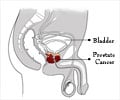A new study reveals men with low risk and localized prostate cancers can choose active surveillance or watchful waiting .

The researchers, led by Julia Hayes, MD, a medical oncologist in the Lank Center for Genitourinary Oncology at Dana-Farber, said their findings support observation - active surveillance and watchful waiting - as a reasonable and underused option for men with low-risk disease.
"About 70 percent of men in this country have low-risk prostate cancer, and it's estimated that 60 percent of them are treated unnecessarily" with various forms of radiation or having the disease removed with radical prostatectomy surgery, said Hayes, who is also a senior scientist at MGH's Institute for Technology Assessment. A clinical trial called PIVOT reported that such men had about the same small risk of death over a 12-year period whether they underwent radical prostatectomy or simply observation.
Hayes and her co-authors created mathematical models to construct a variety of scenarios, focusing on men ages 65 or 75 at diagnosis, and including estimated costs associated with treatment and different forms of observation.
In active surveillance (AS), patient undergo blood tests for prostate specific antigen (PSA) every three months, rectal examinations every six months, and a prostate gland biopsy at one year and then every three years. If the tests find the cancer is more aggressive than originally thought, the patients begin treatment aimed at curing the disease. "This approach could also be described as deferred treatment," said Hayes.
A patient who chooses watchful waiting (WW) is observed without intensive monitoring and is given palliative treatment when the cancer becomes symptomatic.
Treatments for low-risk prostate cancer include radical prostatectomy, intensity-modulated radiation therapy (IMRT) or brachytherapy (radioactive seed implants.)
Advertisement
The bottom line result was that observation was more effective and in some cases less costly than initial treatment for low-risk prostate cancers. Watchful waiting yielded 11 months additional QALE over brachytherapy - the most effective treatment - and 13 months additional QALE over radical prostatectomy, the least effective treatment.
Advertisement
Study co-author Philip Kantoff, MD, director of the Lank Center for Genitourinary Oncology at Dana-Farber and a professor of medicine at Harvard Medical School, commented: "This study delineates the cost benefit of active surveillance as well as watchful waiting - the less aggressive assessment strategy."
"A previous study by Dr. Hayes and colleagues demonstrated that active surveillance is a reasonable option for men with low-risk disease and associated with a better quality of life," Kantoff added. "As non-treatment becomes a more accepted option for these patients, selecting those who require less aggressive assessment including biopsy will become important."
The study's senior author is Pamela McMahon, PhD, at MGH's Institute for Technology Assessment. Others include Daniel Ollendorf, MPH, and Steven Pearson, MD, MSc, of the Institute for Clinical and Economic Review; Michael Barry, MD, of MGH; and Pablo Lee, BS, of MGH's Institute for Technology Assessment.
The research was supported by National Cancer Institute grant CA92203-08, Department of Defense grant W81XWH-09-0512, and a grant from the Prostate Cancer Foundation.
About Dana-Farber Cancer Institute
Dana-Farber Cancer Institute is a principal teaching affiliate of the Harvard Medical School and is among the leading cancer research and care centers in the United States. It is a founding member of the Dana-Farber/Harvard Cancer Center, designated a comprehensive cancer center by the National Cancer Institute. It provides adult cancer care with Brigham and Women's Hospital as Dana-Farber/Brigham and Women's Cancer Center and it provides pediatric care with Boston Children's Hospital as Dana-Farber/Boston Children's Cancer and Blood Disorders Center. Dana-Farber is the top ranked cancer center in New England, according to U.S. News & World Report, and one of the largest recipients among independent hospitals of National Cancer Institute and National Institutes of Health grant funding. Follow Dana-Farber on Facebook
Source-Newswise


![Prostate Specific Antigen [PSA] & Prostate Cancer Diagnosis Prostate Specific Antigen [PSA] & Prostate Cancer Diagnosis](https://images.medindia.net/patientinfo/120_100/prostate-specific-antigen.jpg)








